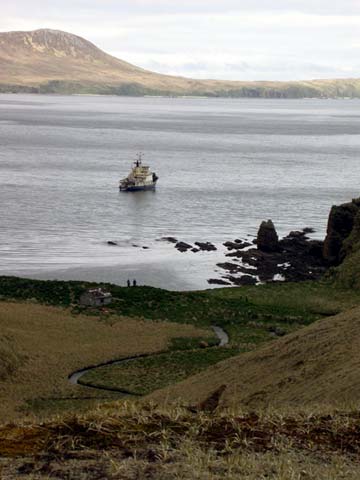 By Ned Rozell November 21, 2006
Agattu Island is a treeless green expanse of tundra and small mountains, located, about as far west as you can go in Alaska. Ptarmigan lived there for centuries before Russian and, later, American trappers found a good way to produce arctic fox pelts was to leave a pair of fox on an Aleutian island and return in few years to harvest their offspring. While the luxurious coats of the foxes brought trappers heaps of money, the foxes they introduced ate all the ptarmigan and eggs in their unprotected nests. By the late 1930s, ptarmigan disappeared from Agattu, but somehow survived on the nearby, much larger island of Attu. For years, biologists with the Alaska Maritime Wildlife Refuge have recognized how destructive foxes were to the ground-nesting birds in the Aleutians. They started killing foxes on islands in 1949 and discovered that it was possible to remove every single one from an island with a few years of effort. After refuge biologists removed all the foxes from Agattu in the 1970s, biologists wondered if birds that were missing from the island, such as the Evermann's rock ptarmigan, could make a comeback there. After four years of ferrying ptarmigan between Attu and Agattu on the refuge ship the Tiglax, the answer appears to be yes. Steve Ebbert is a wildlife biologist with the refuge based out of Homer who was in charge of the project. Beginning in spring 2003, he and volunteers including Clait Braun, one of North America's experts on grouse and ptarmigan, captured male and female ptarmigan on Attu, placed them in cages, and carried them 30 miles across the North Pacific to Agattu. During four years, the team moved 75 ptarmigan from Attu-an island so large and mountainous that ptarmigan may have used the extreme terrain to avoid the foxes that were there until 1999-to Agattu. "The first two years we focused on capturing ptarmigan on Attu and didn't spent much time checking on the released birds (on Agattu)," Ebbert said. This year, a graduate student who spent the last two summers tracking the ptarmigan and their offspring on Agattu has declared the transplants a success. "I believe the (team of biologists) has successfully established a breeding population of Evermann's rock ptarmigan on Agattu Island," Robb Kaler of Kansas State University wrote in a recent report to the Alaska Department of Fish and Game. Kaler found ptarmigan on Agattu that were the descendents of birds that Ebbert and his coworkers released on the island in 2003, 2004, and 2005. A wet, cold summer in 2006 made for a tough breeding season for the birds this year (in which many Agattu chicks perished), but Kaler estimated there are now at least 25 pairs of ptarmigan on the island, which is 20 miles long and five-to-10 miles wide. He said the Evermann's rock ptarmigan, a rare subspecies of ptarmigan found only on Attu and Agattu, is one tough bird. "We're fortunate that ptarmigan are quite hardy," Kaler said from his office in Manhattan, Kansas. "You can capture them, put them in a box, drive them across the ocean 30 miles, and within two weeks they're right at home. Not only do they nest, but they raise a brood to independence the same year." The ptarmigan return to Agattu is a quiet success story because of where it occurred-an island few people will ever see-but it's noteworthy because few species ever return after a manmade disturbance pushes them out. The Aleutians, because of their remoteness, lack of people, and legal protection as a wildlife refuge, are one of the few places in America such a happy ending is possible.
University of Alaska Fairbanks, in cooperation with the UAF research community. Ned Rozell is a science writer at the institute.
|
||
